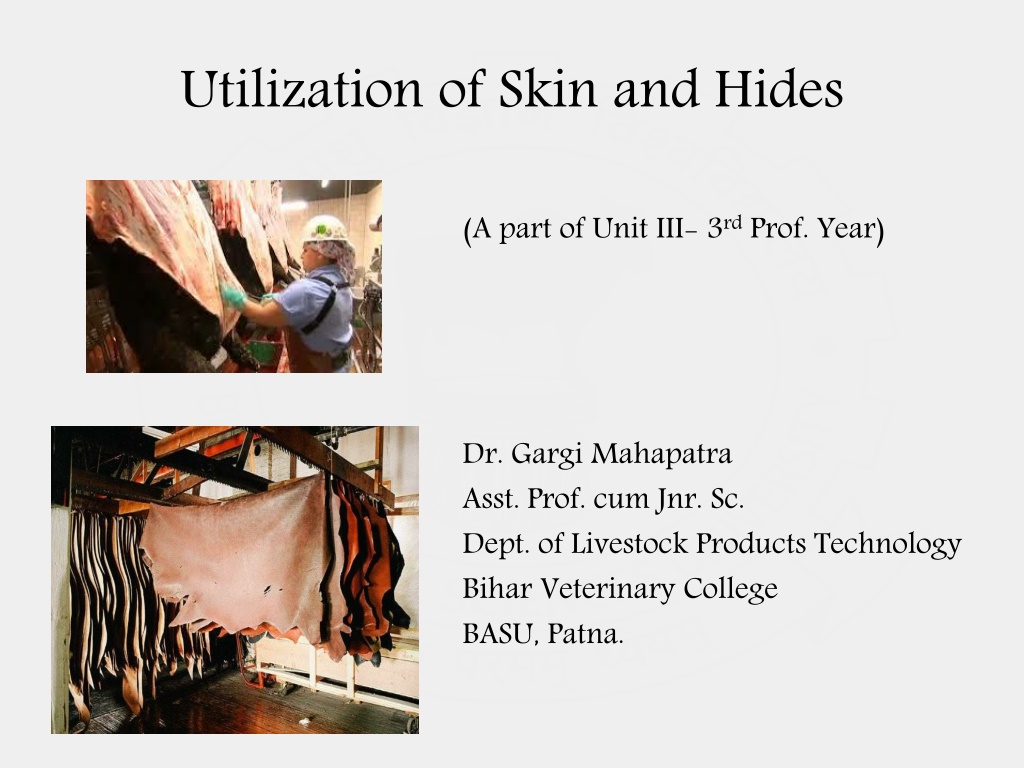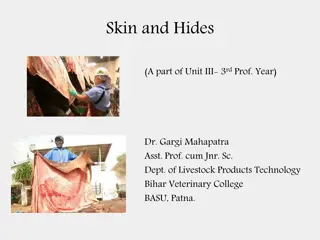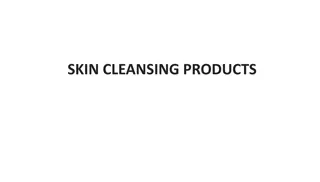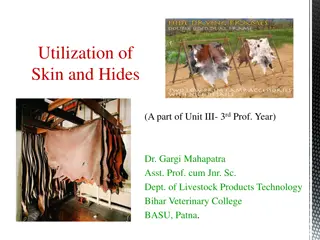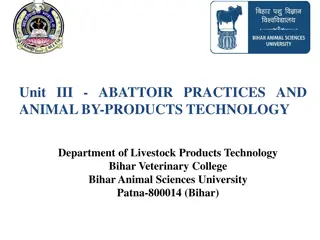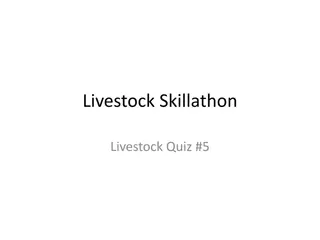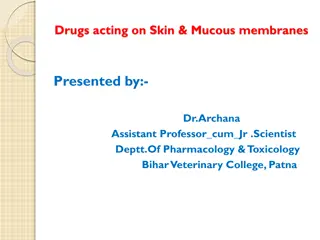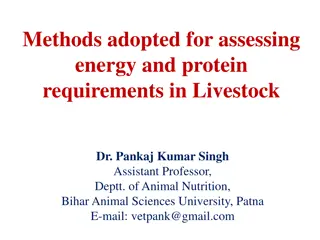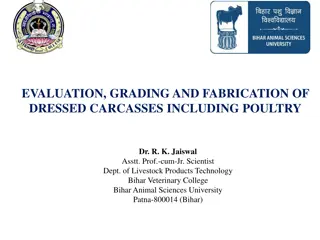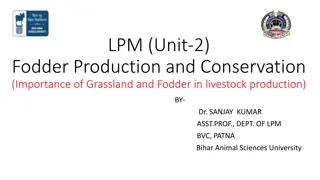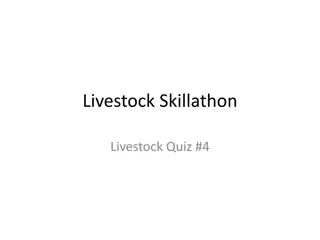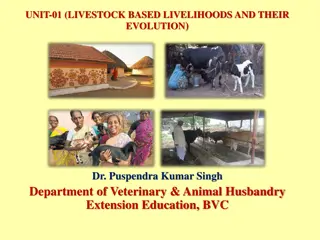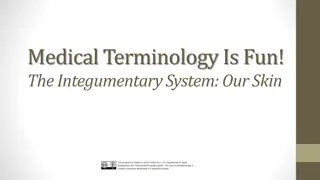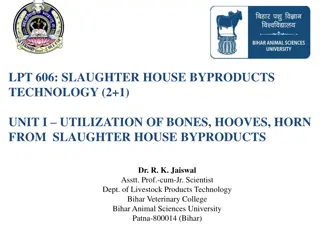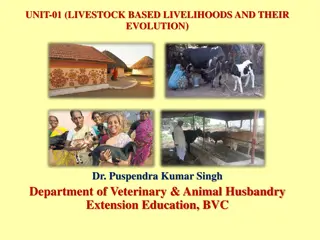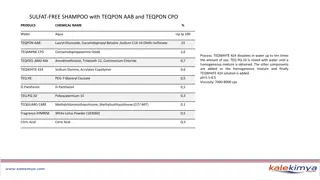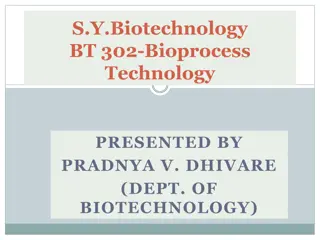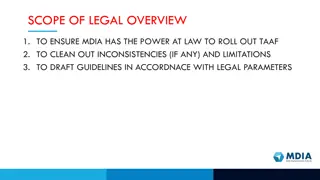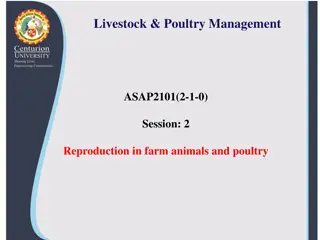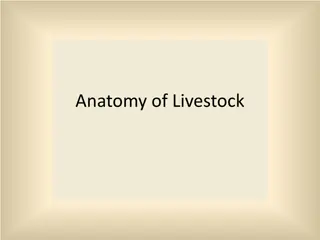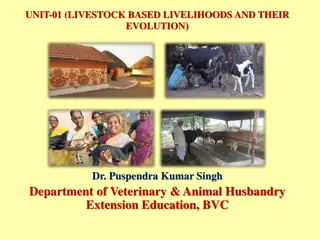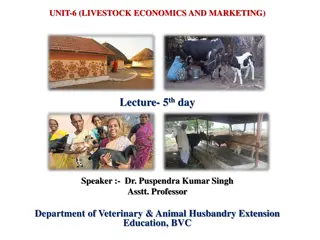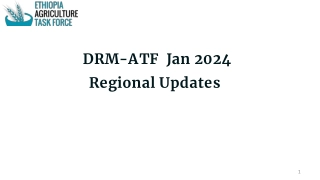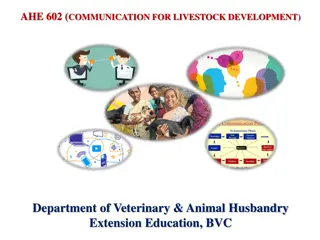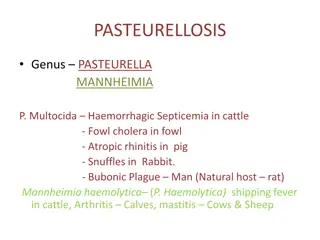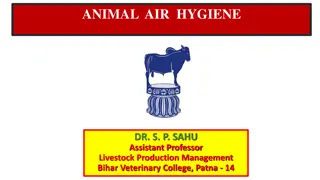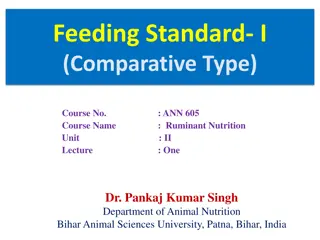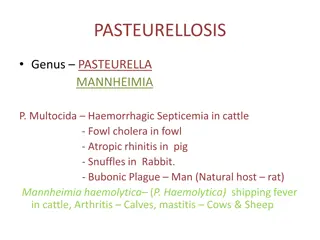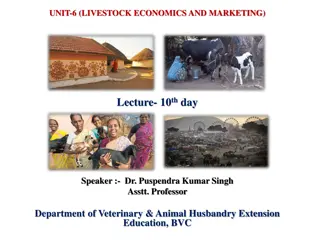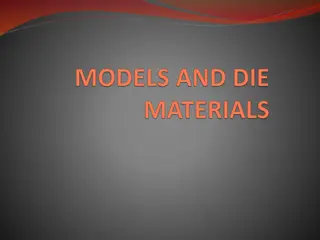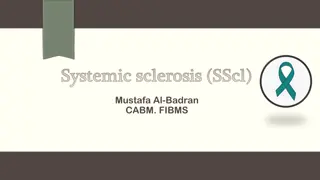Skin and Hides Utilization in Livestock Products Technology
Skin and hides are important by-products obtained from slaughtered and fallen animals, with different characteristics and yields. The process involves flaying to separate the hide from the animal's body, followed by various treatments to produce leather. Leather, with its excellent strength, flexibility, and resistance, finds versatile usage in various products. The cross-section of hide/skin reveals layers of epidermis, dermis, and subcutis that form leather. Skilled workers perform the intricate flaying process using specialized tools. The utilization of skin and hides is an essential aspect of the livestock industry, contributing to the production of high-quality leather products.
Download Presentation

Please find below an Image/Link to download the presentation.
The content on the website is provided AS IS for your information and personal use only. It may not be sold, licensed, or shared on other websites without obtaining consent from the author. Download presentation by click this link. If you encounter any issues during the download, it is possible that the publisher has removed the file from their server.
E N D
Presentation Transcript
Utilization of Skin and Hides (A part of Unit III- 3rdProf. Year) Dr. Gargi Mahapatra Asst. Prof. cum Jnr. Sc. Dept. of Livestock Products Technology Bihar Veterinary College BASU, Patna.
Hide vs. Skin (one of the most important by-products) Hide Skin of Large Animal Hide Skin Skin Skin of Small Animal or very young calf Small, Thinner and Tighter Large, Thick and Heavy Wt. < 20lbs/9.1 kg Wt. > 30 lbs/ 13.62 kg Av. Yield 11.0% of live wt. Av. yield 7.0% of live wt.
Source Hide Hide Skin Skin Slaughtered animals 20-25 % Slaughtered animals 80 % Fallen Animals 75-80% Fallen Animals 20% * Fallen animals: Death due to natural cause
Destination of Hide/ Skin Hide/Skin Drying/ Curing Conditioning Tanning Post-Tanning Operations Leather (End Product)
Leather Excellent tensile strength and flexibility High resistance to puncture and tear Insulation from weather Good molding tendency hence versatile usage.
Cross-section of Hide/Skin Epidermis- Outer pigmented zone Dermis- a.k.a Corium, (elastin fibres+ reticular fibres+ collagen fibres) Subcutis- Loose membrane network of fatty deposits. *Inner portion of corium is interwoven with bundles of collagen which makes up into leather. *Inner portion of corium is interwoven with bundles of collagen which makes up into leather.
Flaying Process of skin removal Performed by skilled workers Sharp flaying knives used. Practiced on Pritch Plates :- Steel plates 120cms long, 60cms wide and 20 cms thick. Animal secured on pritch plates by Pritch Bars: A metal rod. Sometimes practiced on skining cradles, made from round steel/timber tublings. https://www.youtube.com/watch?v=9y03R9WVnGY Process of skin removal from from dead animal dead animal
Flaying of Large Animals Hide opened from neck (ventral side) Incision continued from middle of dewlap to belly up to the middle of tail Cut created at knee joint and hock joint Fore leg incision continued to breast bone Hind leg incision continued to scrotum/udder Hide separated from carcass from breast to neck and from breast to navel
Contd Contd Incisions are moved towards the medial end of the carcass The carcass is hung by hooks on its hind legs The hide is removed from the tail Carcass is raised high, the hide is pulled back to the hump, then to the shoulders and finally to the neck, separating the thick subcutaneous tissues Hide is severed from the carcass by giving a cut behind the horns
Flaying of Fallen Animals Difficult due to harder connective tissue. Coagulated blood capillaries stain the hide Leads to inferior quality stained leather Practiced on Flaying Cradles: Two poles 150cms long and 15cms in diameter, separated by a gap of 30cms
Flaying of Small Animals Small incision in the hind leg on inner side of hock joints Smooth and narrow wooden/steel rod (45cms) inserted from the incision to loosen connective tisue between skin and body Rod removed, hand cut made around incision hole Air pumped in the cut, carcass inflates like a balloon
Contd Carcass lifted from ground and hung on hind legs Contd Circular cut made around knee and hock joint and around neck to severe the head Cuts made from the hock joint to scrotum, fingers inserted into the incision and the skin is pulled downwards, continued till worker reaches the chest Worker grips the skin with both the hands and removes it with force, knife used where it is absolutely necessary https://www.youtube.com/watch?v=lqqBU5T3Gas
Classification of Hides and Skin Acc. to weight Name ( (lbs Slunk Skin Calf Skin Kip Skin Heifer Skin Cow Hide Light Cow Hide Heavy cow Hide Extreme Light Hide Light Steer Hide Heavy Steer Hide Bull Hide Acc. to weight Other factors Name Texas/Colorado hide Other factors Name Description Hides branded on butt. Description Name Origin Origin Weight lbs) ) --- 9-15 15-25 25-30 >30 <53 >53 32-48 Weight Unborn Calf Immature Calf Calf Heifer Cow Cow Cow Steer Native hides Slaughtered Hides Unbranded Hides Flaying of slaughtered animals Fallen/ Rendered/ Murrian Hides Flaying of Fallen animals Big Packers Hide Flaying by highly skilled workers Steer Steer Bull 48-58 > 58 60-100 Small Packers Hide Flaying by less skilled workers
Goat Skin Classification FAO FAO On the basis of weight and length (Baba and Bhote, 1966) Class (kg) Big Goat Skin On the basis of weight and length (Aten, 1955) Grades First Grade Class Wt. (kg) 1.3 Wt. Length ( (cms > 96.5 Length cms) ) Region Region Grades Specification Shape/Pattern Regular and Symmetrical with minor scores/gouges Good Shape and Pattern, 1/16 of area show concentrated scores/gouges Irregular shape and Pattern; of the area damaged by knife Irregular shape and Pattern; Extensive damage on back or butt Specification Punjab, Kashmir, Odhisa , U.P. Rajasthan, Maharasht ra, Andhra Pradesh, Kerela, Karnataka Eastern Part of India Second Grade Medium Goat skin 0.91 76.2- 96.4 Third Grade Reject Grade Small Goat Skin 0.86 <76.2
Defects in Hide/Skin Ante Poor substance Factor/ Species variation 2. 2. Defects due to Disease Pox, Mange, Dermatitis etc. 3. 3. Grain Damage wire fence scratches, branding, abscess abrasion, tick damage, bacterial action Ante- -mortem Defects Poor substance- - Genetic mortem Defects Post Bad Shape/ Pattern - - Ground drying, Fallen hides etc. 2. 2. Bad Flaying 3. 3. Curing Defect improper application of salt 4. 4. Smoke damage exposure to smoke. Post - -mortem Defects 1. 1. Bad Shape/ Pattern mortem Defects 1. Defects due to Disease - Bad Flaying - -Knife Cut Curing Defect - -Salt burns, Grain Damage - -Thorns or Smoke damage - -Excessive
Preservation of Hides and Skin Drying Drying First step in hide preservation- Methods Air Drying & Practiced in areas where relative humidity is low Hide Curing Done immediately after flaying Techniques Dry Salting Wet Salting Techniques Ground Drying Suspension Drying (Frame Drying, Line Drying & Tent Drying)
Important points Important points Skin of sheep and long haired goats are washed on the flesh side up. After drying the hides are conditioned and then sent to tanneries. Green Hides- Fresh hides which have been flayed, fleshed, trimmed and washed. These are delivered to the tanneries as early possible.
Ground Drying Ground Drying Hides stretched out fleshed side up on the ground and air dried. Advantages: Cheap, Easily adaptable by rural population Advantages: Adequate for Fallen hides Disadvantages Blemishes follicular level hence poor quality leather produced. Disadvantages: : and Putrefaction at High temperature(summers) causes wrinkling
Suspended Drying Suspended Drying Hides are dried in suspended manner Advantages Simple, cheap and effective way of drying. Easily adaptable in tropical countries. Free circulation of air around the hide. Skin becomes lighter thus cheaper to transport. Advantages
Suspended Drying Techniques Frame Drying Practiced on angled frames fixed on a tripod/stand Suspended Drying Techniques Tent Drying Hide supported on ground in shape of a tent by chords and wires Line Drying Skin suspended on horizontal chords with flesh side up, practiced for sheep and goat *Irrespective of the method of drying hide takes a minimum of 7 days to dry. *Irrespective of the method of drying hide takes a minimum of 7 days to dry.
Hide curing Dry Salting Wet Salting (Hide retains 35% water) Curing solution prepared (23 kg salt+ 62 kg water for 100 kg of hides) Hides soaked in pits, 1.25m deep. Soaking times varies from 2 days for fleshed hides to 2 weeks for un-fleshed hides. Brining liquid maintained at room temperature. (Hide retains 12% water) Hides kept flesh side up 2-3 mm thick layer of fine salt applied Weight of salt equal to weight of hide Hides stacked on one another, to a max. height of stack 1m. Practiced in rooms maintained at 15 C and 85- 90% relative humidity.
Conditioning of Hides Washing and Soaking Washing and Soaking (Hides soaked in zinc chloride+ soda ash+ borax Solution) All proteins of blood and lymph removed Hide rehydrates and restores its shape Fleshing Fleshing Extra flesh stripped off with a serrated knife Liming and Liming and Dehairing Dehairing Hides soaked in saturated lime solution with 0.1% sodium sulphide Applied to loosen hair and epidermal cells
Contd Contd . . Washing and Washing and Deliming Deliming Hides washed with mild acid to neutralize the lime Batting Batting Hides treated with proteolytic enzymes at pH 8.5 Results in soft and pliable pelt Such pelts tanned by vegetable tanning Pickling Pickling Pelts pickled in bath of 1% Sulphuric acid and 10% salt in water, maintained at a pH of 2-2.5 for 2-3 hrs Such pelts are tanned by chrome tanning process
Tanning Process of conversion of hides/ skins to insoluble and non-putrescible leather without destruction of original structure. Process requires approximately 5-6 hrs Types Vegetable Tanning Chrome Tanning
Vegetable Tanning Vegetable Tanning Delimed pelts are immersed in natural tanning liquor of progressively stronger concentration. The tannin diffuses and imparts uniform colour Used for heavy leather articles like belts, saddle, harness etc. Tanning producing plants are Avaran ( Cassia auriculata), Babul (Acacia arabia), Myrabalan (Terminalia chebula) Konnan (Cassia fistula).
Chrome Tanning A more modern, quicker and popular technique. Yields softer, stronger and supple leather. Types 1. applied on skin. The strength of the solution is then gradually increased 2. solution is practiced on skin itself. sulphuric acid to get chromic sulphates. then increased to pH of 3.5. Chrome Tanning Single Bath Process- Chrome salts prepared in a solution and then Double Bath Process- Chemical interaction forming the chrome Usually sodiumbichromate is reacted with maltose and Chromic sulphates are applied @ 1.5-2.0% at a pH of 2.5 ,
Post tanning Operations Setting out and Wiring Hide passed between two large rollers Remove excess of tanning liquor and moisture Setting out and Wiring Splitting and Shaving Practiced to adjust leather thickness Splitting and Shaving Dyeing Dyeing To produce desired color Fat Liquoring Fat Liquoring Lubrication with oil to adjust firmness
Contd Contd Staking Staking Makes the leather more pliable Buffing Buffing Smooth the grain surface of leather for better appearance Final product is called buffed leather Glazing Glazing Done in case of chrome tanning Glass cylinders are rolled on the surface of the buffed leather This process produces high luster on the grain surface
